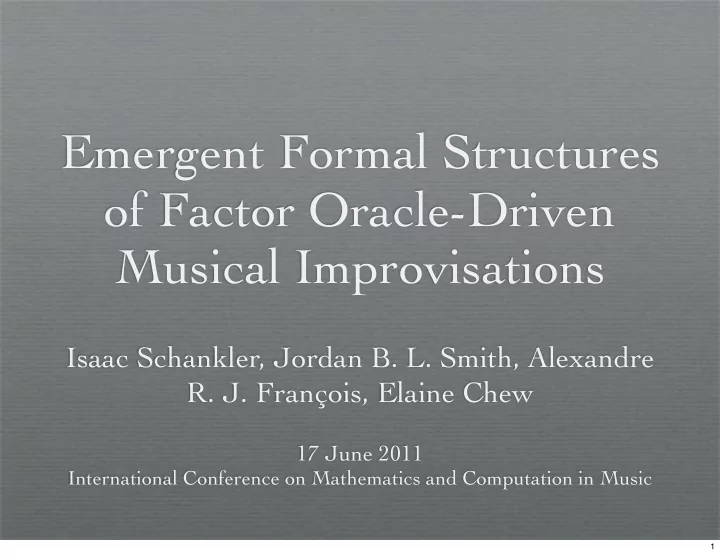

Emergent Formal Structures of Factor Oracle-Driven Musical Improvisations Isaac Schankler, Jordan B. L. Smith, Alexandre R. J. François, Elaine Chew 17 June 2011 International Conference on Mathematics and Computation in Music 1
The Mimi Project: Multimodal Interaction in Musical Improvisation Inspired by the OMax project at IRCAM – a little sister of the ! OMax brothers Implemented by Alexandre François using his Software ! Architecture for Immersipresence (SAI) Mimi 1.0 : by François, Chew, Thurmond [ACMCIE], ! premiered at 1st MCM meeting, Berlin 2007, on a Seiler piano Mimi4x : by François, Schankler, Chew [IMIDA, IJART], ! installation for high-level structural improvisation Mimi 1.5 : by François, Schankler, Chew, featured in concerts: ! PiE, etc. 2
The Mimi Project: Multimodal Interaction in Musical Improvisation Inspired by the OMax project at IRCAM – a little sister of the ! OMax brothers Implemented by Alexandre François using his Software ! Architecture for Immersipresence (SAI) Mimi 1.0 : by François, Chew, Thurmond [ACMCIE], ! premiered at 1st MCM meeting, Berlin 2007, on a Seiler piano Mimi4x : by François, Schankler, Chew [IMIDA, IJART], ! installation for high-level structural improvisation Mimi 1.5 : by François, Schankler, Chew, featured in concerts: ! PiE, etc. 2
The Mimi Project: Multimodal Interaction in Musical Improvisation Inspired by the OMax project at IRCAM – a little sister of the ! OMax brothers Implemented by Alexandre François using his Software ! Architecture for Immersipresence (SAI) Mimi 1.0 : by François, Chew, Thurmond [ACMCIE], ! premiered at 1st MCM meeting, Berlin 2007, on a Seiler piano Mimi4x : by François, Schankler, Chew [IMIDA, IJART], ! installation for high-level structural improvisation Mimi 1.5 : by François, Schankler, Chew, featured in concerts: ! PiE, etc. 2
Mimi demonstration 3
Question ! When a human improviser interacts with Mimi, what kinds of structures emerge? 4
Question ! When a human improviser interacts with Mimi, what kinds of structures emerge? ! Do the performer and a listener perceive the structures differently? 4
Experiment ! Isaac performed three improvisations with Mimi ! The sessions were recorded ! The recordings were analyzed by (1) the performer, Isaac, and (2) a skilled listener, Jordan ! The annotations were compared 5
Results Recording #1 6
Results Recording #1 6
Results Recording #1 6
Results Recording #2 7
Results Recording #3 8
Results ! Boundaries in small-scale analyses tend to be closely aligned ‣ Interpretation of boundaries was similar ! Labels in large-scall analyses tend to coincide ‣ Large-scale organization is similar 9
Evaluation ! Visual comparison reveals many similarities, but these judgements are subjective. ! Four empirical evaluation metrics were considered: ! Boundary precision and recall ! Pairwise precision and recall ! Average cluster and speaker clarity ! Rand index 10
Boundary precision and recall Annotation ✓ ✓ ✓ ! ! ✓ ✓ ✓ ! ! ! ! ! Estimate Precision: 3/8 Recall: 3/5 f -measure: 2pr/(p+r) = 37.5% = 60% = 46% 11
Pairwise precision and recall ! ! ! " " $$$ !""#$%$&#"' ! ! " # " $$$ ()$&*%$+' Precision: 1/2 Recall: 1/4 f -measure: 2pr/(p+r) = 50% = 25% = 33% 12
Baselines ! Empirical comparisons more or less meaningless without some baseline for comparison ! Many baseline strategies were used; the best- performing one placed 10 boundaries randomly throughout the piece and assigned segment labels randomly 13
Results 14
Question ! When a human improviser interacts with Mimi, how do structures emerge? 15
The Canon ! Mimi’s actions are delayed by 10 seconds ! If no recombination occurs, together Mimi and the human performer create a canon at the 10- second level 16
Canon-like forms 17
The Rondo ! Mimi may revisit pieces of musical material, creating a sense of return ! If Mimi is continuously learning, material learned earlier is more likely to be heard again than material learned later 18
Rondo-like forms 19
Large-scale formal divisions ! Mimi’s memory can be cleared, allowing the creation of large-scale formal divisions 20
More large-scale formal divisions 21
Rhythmic cells ! On a smaller scale, Mimi’s performances exhibit similar structural tendencies ! Similar to personnages rhythmiques found in the music of Stravinsky and Messiaen, but always immobile 22
Rhythmic cells 23
Rhythmic cells 23
Rhythmic cells 23
Summary ! Questions: ! When a human improviser interacts with Mimi, what kinds of structures emerge, and how do they emerge? ! Answers: ! Familiar structures (canon, rondo, etc.) ! By virtue of Mimi’s programming ... 24
Thanks for your attention! 25
Recommend
More recommend